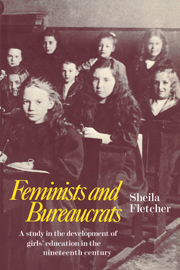Book contents
- Frontmatter
- Contents
- Preface
- Introduction: The Endowed Schools Act
- 1 The shaping of Section 12
- 2 The men who rejected the dead hand
- 3 The money problem
- 4 Opponents
- 5 Supporters
- 6 What was achieved
- 7 The changeover of 1874
- 8 The long haul
- 9 The Charity Commission spirit
- 10 The women's movement in the later years
- Appendices
- Notes
- Select Bibliography
- Index
9 - The Charity Commission spirit
Published online by Cambridge University Press: 07 October 2011
- Frontmatter
- Contents
- Preface
- Introduction: The Endowed Schools Act
- 1 The shaping of Section 12
- 2 The men who rejected the dead hand
- 3 The money problem
- 4 Opponents
- 5 Supporters
- 6 What was achieved
- 7 The changeover of 1874
- 8 The long haul
- 9 The Charity Commission spirit
- 10 The women's movement in the later years
- Appendices
- Notes
- Select Bibliography
- Index
Summary
It is well known that the Charity Commissioners have excited no feeling of hostility throughout the country; on the contrary they have displayed singular prudence and common sense.
Patric Cumin, 1874If Young's vitality recalls the old days a glance once more at the relative achievements of the Charity Commissioners and their predecessors in this field of girls' education makes quite clear that the old days had gone. Lyttelton and his colleagues were responsible for Schemes establishing 178 grammar schools, of which 47 were for girls and one was mixed. The Charity Commissioners were responsible for Schemes establishing 335 grammar schools, of which 47 were for girls and 6 were mixed. If the mixed schools are divided equally between the sexes, then girls'schools comprise 27 per cent of the output of the Endowed Schools Commissioners and 15 per cent of their successors'. This is a significant difference and one to which other noticeable differences, such as time-scale and total work-load, are irrelevant.
No one, one imagines, would have been more surprised at such an outcome than the Charity Commissioners. In 1886 the Select Committee appointed to inquire into the Endowed Schools Acts heard that a great deal had been done for girls. ‘I may say at once that we have been able to act upon that section very largely,’ said Richmond, while Young, who was in charge of endowed schools work, spoke of the necessities of female education as ‘specially commended to us by this clause’. They could certainly claim to have favoured it, he said, ‘as indeed under the terms of the Act we are bound to do’.
- Type
- Chapter
- Information
- Feminists and BureaucratsA Study in the Development of Girls' Education in the Nineteenth Century, pp. 151 - 170Publisher: Cambridge University PressPrint publication year: 1980



